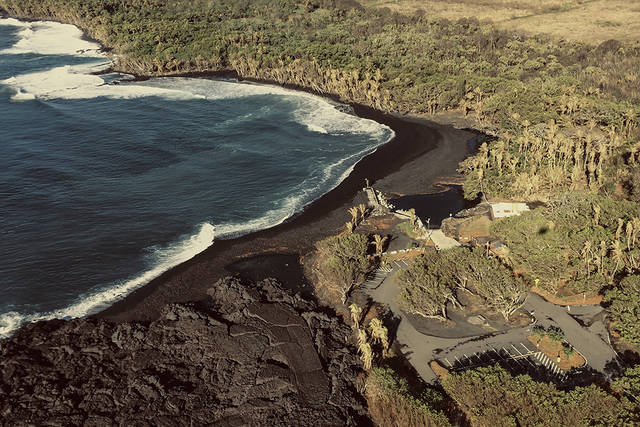Recovery from Kilauea eruption might cost $800M

COURTESY U.S. GEOLOGICAL SURVEY
A sand bar, comprised of black sand and lava fragments carried by longshore currents from the lava delta, continues to block the boat ramp at Isaac Hale Beach Park, Friday.
County officials now estimate the price tag for the recovery of Puna in the wake of the Kilauea Volcano eruption will be more than $800 million, but Mayor Harry Kim said Friday most of that would come from federal or county sources and not from the state.
A previous county estimate put the cost of the recovery plan at $671 million, and Kim told emergency workers at a briefing Friday morning that there has been a “huge misunderstanding” that the county is asking the state for most or all of that money.
In fact, the total sum includes money that will come from the Federal Emergency Management Agency and county contributions. For example, the federal government is expected to pay 75 percent of the repair of roadways that have been buried by lava, Kim said.
“If I were to make round numbers of how much of that will be state money, probably less than $100 (million), and that’s the truth,” Kim said. “The bulk of it will be federal, hopefully.”
A summary sheet of the latest proposal shows the state share of the entire package would be $112 million.
Of that amount, the latest proposal seeks $55.2 million in “immediate” state funding, including funding for emergency response staff such as police and other employee overtime and equipment costs. The county is seeking a total of $95 million in immediate funding from all sources, although it is not clear how large the county share of those costs would be.
Don't miss out on what's happening!
Stay in touch with breaking news, as it happens, conveniently in your email inbox. It's FREE!
Kim said it may not be necessary for the state Legislature to hold a special session this year if Gov. David Ige’s administration can find the funds to help the county, but the county does need near-term help with its emergency costs. The county has a cash-flow problem, with unbudgeted costs draining off too much of its available funding.
“If we do not get assistance from the state government in regards to our emergency response — and it’s still ongoing — then our whole budget has to be reviewed,” Kim said.
State lawmakers have pressed the Kim administration for more details on the immediate needs in a recovery package being developed by the county, and county officials met with leaders from the state Senate on Friday to discuss the package.
House Speaker Scott Saiki said the House declined to join in the Friday meeting in Hilo because House lawmakers want a tally of the costs of both the Kilauea eruption and the flooding caused by Hurricane Lane. That is not yet available, but House lawmakers are expected to meet with county officials on Oahu next week.
The county has not released details of its latest draft recovery plan, but an earlier version included a lump sum of $196 million to buy property or compensate landowners in the most risky areas in what is known as Lava Zone 1, according to a document detailing the plan.
In addition to the possible purchases of property in Lava Zone 1, the draft plan also envisioned housing assistance totaling $152 million, including developing a new subdivision on vacant state land in the Keonepoko area of Puna. The latest version of the plan would increase that amount to $162 million.
The earlier draft also described $144 million in public infrastructure projects including roads, a new regional transit hub, relocating the Keaau police and fire stations, replacing a public charter school that was displaced by the lava flow, and replacing beach parks, according to the document.
The amount needed for public infrastructure has now been increased to $244 million, according to the summary sheet, although details of how that money would be spent were not available.
The eruption that began May 3 has opened 24 fissures and covered more than 6,000 acres of land in Lower Puna with lava, destroying more than 700 homes in the Leilani Estates and Kapoho areas, and burying or isolating more than 1,600 acres of farms.
Ige already has released $12 million in state funding to help the county cope with the immediate eruption costs such as police overtime and operating shelters for evacuees.



